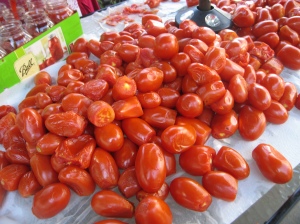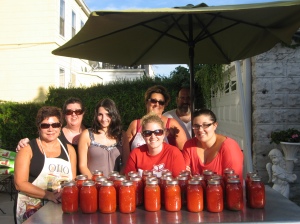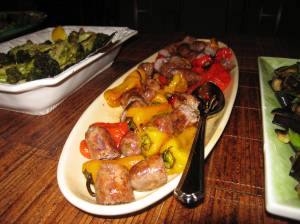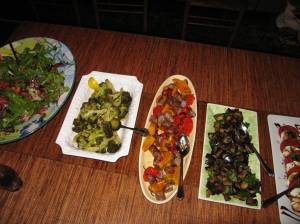This is almost as bad as the olive oil scare a few years ago!
According to a Wall Street Journal article published yesterday, Florida’s tomato crop has suffered due to January’s freezing temperatures.

tomatoes growing in my Aunt Pina's yard in Paestum, Italy. The south-western coast.
From the article:
“Reggie Brown, executive vice president of Florida Tomato Growers Exchange, a Maitland, Fla., trade group, said Tuesday that a 25-pound box of tomatoes is trading for $30, compared with $6.45 a year ago.”
According to the U.S. Agriculture Department, about one-third of fresh vegetables such as tomatoes, bell peppers and sweet corn consumed in the U.S. this time of year come from Florida farms. About two-thirds of this type of produce is imported, and most of that is from Mexico. In recent weeks, weekly vegetable shipments from Mexico to the U.S. have soared by as much as 50% over year-ago levels, according to the USDA.
THIS IS WHY WE NEED TO EAT SEASONALLY!
Tomatoes, bell peppers and corn are not traditionally in season until June lasting to mid autumn. While I feel bad for the major hit to Florida farmers (just pile it ontop of the US economic downturn list) people need to be educated on how their choices effect simple supply and demand across this country.
Hold off on fresh tomatoes during the winter months. Towards the end of their season you might want to think about jarring, or freezing.
Here are some Freezing tips from the University of California Division of Agriculture
Freezing Tomatoes
Tomatoes may be frozen whole, sliced, chopped, or puréed. Additionally, you can
freeze them raw or cooked, as juice or sauce, or prepared in the recipe of your
choice. Thawed raw tomatoes may be used in any cooked-tomato recipe. Do not try
to substituted them for fresh tomatoes, however, since freezing causes their texture
to become mushy. Tomatoes should be seasoned just before serving rather than
before freezing; freezing may either strengthen or weaken seasonings such as garlic,
onion, and herbs.
Preparation
Select firm, ripe tomatoes for freezing. Sort the tomatoes, discarding
any that are spoiled. Wash them in clean water as recommended above.
Dry them by blotting with a clean cloth or paper towels.
Freezing whole tomatoes
Prepare tomatoes as described above. Cut away the
stem scar. Place the tomatoes on cookie sheets and freeze. Tomatoes do not need to
be blanched before freezing. Once frozen, transfer the tomatoes from the cookie
sheets into freezer bags or other containers. Seal tightly. To use the frozen tomatoes,
remove them from the freezer a few at a time or all at once. To peel, just run a
frozen tomato under warm water in the kitchen sink. Its skin will slip off easily.
If you prefer to freeze peeled tomatoes, you can wash the tomatoes and then
dip them in boiling water for about 1 minute or until the skins split. Peel and then
freeze as noted above.
Here is a fun little video about how jar tomatoes. This woman probably devotes a whole day to this. I love when she yells Basilico! And please excuse the cheesy transitions and title cards.






























